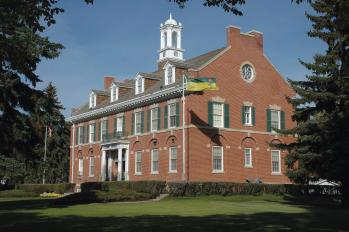
Many of Saskatchewan's most impressive public buildings were designed by its second Provincial Architect, Maurice William Sharon. Sharon was born in St. Thomas, Ontario on November 1, 1875. He graduated from the School of Practical Science (now the University of Toronto's Faculty of Applied Science and Engineering), and then apprenticed six years in architects' offices. Arriving in Regina in 1906, he was first employed by the province as a cartographer and has been credited with drawing the first official map of the new province. He subsequently went into an architectural partnership with a former employer, Neil R. Darrach. Sharon and Darrach's Regina works include Westminster United Church, the Donahue Block, and the Guaranty/Western Trust Building.
Sharon's tenure as Provincial Architect from 1916 to 1930 coincided with the province's boom years. Among his works are the Saskatchewan Hospital at Weyburn, the Provincial Normal School at Saskatoon, and the 1928 ballroom addition to Government House, Regina. However, his most distinctive and prominent designs are several elegant court houses. Yorkton Court House, a Provincial Heritage Property, is an example of the Beaux Arts style; it was featured on the $1 stamp of Canada Post's Canadian Architectural Heritage series. Estevan Court House (also a Provincial Heritage Property) is considered Saskatchewan's finest example of the Colonial style, exhibiting a symmetric design and fine detailing in stone and brick. Sharon's other Colonial courthouse designs are Assiniboia and Weyburn (both Provincial Heritage Properties), Gravelbourg, Kerrobert, Melfort, Prince Albert, Shaunavon, and Wynyard.
Sharon was active in the formation of the Saskatchewan Association of Architects in 1912 and served two terms as its president. A Liberal supporter, Sharon lost his position as Provincial Architect following the election of the Conservative government in 1929. He spent his remaining years in BC, where his few subsequent works have all since been demolished. The excellence of his architectural capabilities is perhaps best attested to by the fact that many of Maurice Sharon's buildings are still standing almost a century later, and over a dozen of them have been formally designated as Municipal or Provincial Heritage Properties. Maurice Sharon died September 8, 1940.
Margaret Sharon